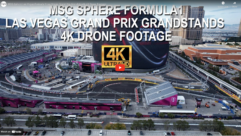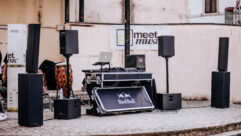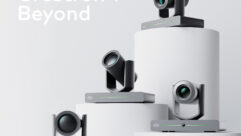
World-changing Event, Part 1
Jun 12, 2008 11:00 AM,
By John W. DeWitt

The 50’x96′ “White Room,” venue for Saatchi & Saatchi’s World Changing Ideas ceremony, presented unique visual and audio staging challenges for PeopleTech Events.
Marketing hype aside, few corporate events legitimately lay claim to changing the world. One is Saatchi & Saatchi’s World Changing Ideas Awards ceremony, honoring innovations that include a collapsible wheel, a brain-computer interface, $100 laptops for impoverished children, and this year’s winning idea—LifeStraw, a portable water purifier that might spare millions from the ravages of waterborne disease. The global marketing firm staged the 2007/2008 awards ceremony in its Manhattan, N.Y., headquarters with the creative, event management, and AV support of Nashville, Tenn.-based PeopleTech Events and audio technology from Meyer Sound.
This year’s award, the fifth time since 1998 that Saatchi & Saatchi has presented the global honor, featured a panel of judges that included: Edward de Bono, Peter Gabriel, His Royal Highness Prince Hassan, Malcolm McLaren, Carolyn Porco, and Philippe Starck. The winner, Vestergaard Frandsen of Switzerland, was announced by Her Royal Highness Princess Badiya of Jordan at the February 21 awards ceremony. Bob Isherwood, Saatchi’s worldwide creative director and the convener of the award, said that “the promise of LifeStraw to bring safe drinking water, for the first time, to more than one billion people on earth is genuinely world changing.”
For PeopleTech Events—which planned and staged the event in collaboration with Satchi’s creative team—the high-profile attendees, the global significance of the ideas being honored, and the event venue itself all combined to create an unusual and inspiring set of challenges.
“This event is an audio-visual type of production—with a small stage, speaking, and video—but it’s much more of a networking event, a meet-and-greet, where the whole room becomes an interactive element with the stage being a secondary note,” explains Chris Simmons, PeopleTech’s project manager and creative director.
From an audio standpoint, the venue—a 50’x96’ loft-like space on the ground floor of a skyscraper dubbed the “White Room,” with a wall of windows running the length of the room—presented various difficulties for sound design, including a mix position situated behind a curtain and a unidirectional sound system that was inadequate for the event.
“It has a concrete, expoxied floor, painted drywall, and large windows, making it quite reflective,” says Michael Corbett, PeopleTech’s system designer and audio engineer. “As it was an awards reception with lots of ambient noise, system intelligibility was a primary concern. At the same time, the show included lots of music, so a full-range audio system was a priority.”
The space was equally daunting for design of visuals and lighting. The client wanted to play off the uniform whiteness of the space to create a museum-like ambiance for the event.
“There was pretty much no rigging in the space, so what we ended up doing was creating a whole floor-supported truss grid for lighting and sound,” Simmons explains. “On the outer edges of the room was a pipe and drape system, with drops printed on material called Stoplight—a white material that you digitally print on and that blocks out the light—so we could cover all the windows across the 100ft. wall and have printed pieces there.”
Also using the truss grid for sound, Corbett designed a multifunctional system that included six Meyer Sound UPJ-1P VariO loudspeakers flown at a height of 14ft. to provide ambient sound. Four flown M1D line array loudspeakers supported the video cube for the awards presentation, and a single M2D-Sub subwoofer provided low frequency.
“With people milling all over the room, we had to achieve foreground-quality coverage while remaining unobtrusive to the reception,” Corbett says.
In Part 2 of this story details the setup for the front-projected video cube.










